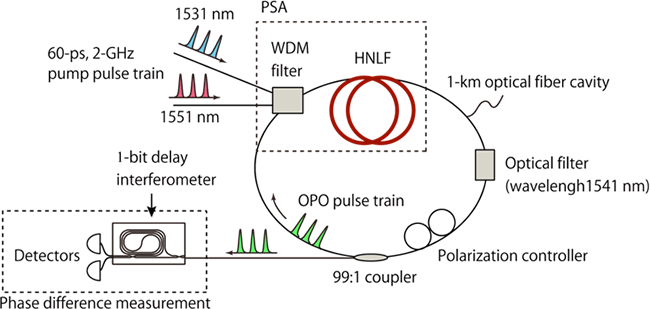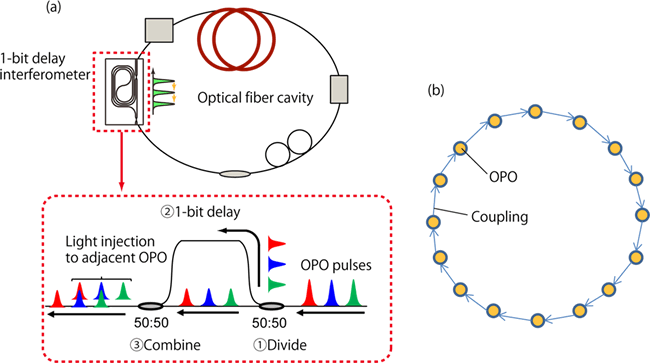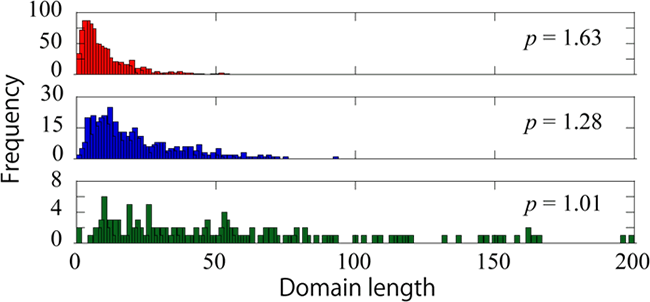Microsoft ends support for Internet Explorer on June 16, 2022.
We recommend using one of the browsers listed below.
- Microsoft Edge(Latest version)
- Mozilla Firefox(Latest version)
- Google Chrome(Latest version)
- Apple Safari(Latest version)
Please contact your browser provider for download and installation instructions.
April 18, 2016
Nippon Telegraph and Telephone Corporation
Japan Science and Technology Agency
Cabinet Office, Government of Japan
Large-scale artificial spin network realized using long-distance optical fiber cavity -An important step toward photonic computation that solves intractable mathematical problems-
Nippon Telegraph and Telephone Corp. (NTT; Head Office: Chiyoda-ku, Tokyo; President: Hiroo Unoura) and Osaka University (Suita, Osaka; President: Shojiro Nishio, Ph.D.) have realized a large-scale artificial spin network based on photonics technologies. This research was funded by the ImPACT Program of the Council for Science, Technology and Innovation (Cabinet Office, Government of Japan) under the program "Advanced Information Society Infrastructure Linking Quantum Artificial Brains in Quantum Network" led by Prof. Yoshihisa Yamamoto. This achievement will provide a fundamental component for the coherent Ising machine (CIM), which is expected to be able to solve combinatorial optimization problems efficiently.
As various systems in modern society grow larger and more complex, analysis and optimization of such systems become increasingly important. Many such operations are classified as combinatorial optimization problems, which are hard to solve with modern digital computers. The research team is now studying the CIM, which utilizes interacting artificial spins realized with optical parametric oscillators (OPO) for computation of combinatorial optimization problems.
The team successfully generated more than 10,000 time-multiplexed OPOs using four-wave mixing in a highly nonlinear fiber (HNLF) placed in a fiber cavity, whose length was as long as 1 km. In addition, it simulated a one-dimensional spin network and found that the OPOs in the network behaved like low-temperature spins, which showed that they could be used as high-quality artificial spins.
Our results constitute an important step towards computers that will be able to solve large-scale combinatorial optimization problems efficiently. This work will be reported in the UK science journal "Nature Photonics" on April 18, 2006.
1.Background
In our society, systems, such as the internet and traffic and social networks, are becoming more and more complex. Therefore, optimizing them is important for efficient use of natural and social resources. Many such problems are reduced to mathematical problems called combinatorial optimization problems, where we find an optimum combination from a finite set of combination. Such problems are known to be very hard to solve with modern digital computers, because the computation time 'explodes' as the number of combinations increases. On the other hand, combinatorial optimization problems can be mapped onto the ground-state-search problems of the Ising model, which is a theoretical model for interacting spins. Today, several institutions are trying to solve the Ising model by using artificial spin networks.
Among 'Ising machines', the CIM is now drawing attention as a way to solve the Ising model efficiently by utilizing artificial spins realized with photonics technologies (Figs. 1 and 2). In the CIM, a group of OPOs is used as spins. An OPO is a special kind of laser oscillator that takes only the 0 or π phase and can therefore be used as a stable artificial spin. The spin-spin interactions can be implemented by mutual injection of OPO lights. With sufficiently slow pumping of the oscillator network, the OPO network tends to start oscillating with the combination of phases that gives the loss-minimum of the whole network, which is the ground state of the corresponding spin network.
In 2014, a group from Stanford University performed a proof-of-principle CIM experiment using four OPOs. However, in order to solve complex combinatorial optimization problems, we need to increase the number of artificial spins.
2.Achievements
We have succeeded in generating more than10,000 time-multiplexed OPOs using an optical fiber cavity as long as 1 km (Fig. 3). This was accomplished by utilizing technologies developed through the R&D of optical fiber communications. The OPOs can be used as artificial spins for a large-scale CIM to solve combinatorial optimization problems in the real world. In addition, we have realized a one-dimensional Ising spin network by introducing nearest-neighbor coupling between OPOs, and found that our room-temperature OPOs can simulate the behavior of low-temperature spins.
Generation of large-scale time-multiplexed OPOs
- (1)We realized a phase-sensitive amplifier (PSA), which is an optical amplifier that amplifies only light with the 0 or π phase, using four-wave mixing in a 1-km HNLF.
- (2)By placing the PSA in a fiber loop, we constructed a 1-km fiber cavity. We then operated the PSA with 2-GHz clock frequency to obtain a total 10,320 OPOs from the single cavity (Fig. 3).
- (3)We experimentally confirmed that the OPO phases were discretized to 0 or π, which suggests that they can be used as stable artificial spins.
Simulation of one-dimensional spin network
- (1)We realized one-dimensional spin coupling by inserting a 1-bit delay interferometer into the fiber cavity (Fig. 5).
- (2)By adjusting the OPO coupling phase, we observed that the spin network can behave like ferro- and anti-ferromagnetic spins. In addition, we confirmed that we could decrease the total network energy by changing the condition of the pump for the OPOs. As a result, we were able to confirm that the OPOs can be used as high-quality artificial spins.
3.Technical Features
(1)Large-scale time-multiplexed OPOs
Figure 3 shows the experimental setup. The 100-ps width, 2-GHz clock laser pulses with wavelengths of 1531 and 1551 nm were injected into a fiber cavity through a wavelength-division multiplexing (WDM) filter. The cavity contained a WDM filter, a 1-km HNLF, a narrowband wavelength filter, a polarization controller, and a 99:1 coupler. Through the four-wave mixing in the HNLF, we can obtain phase-sensitive amplification at 1541-nm wavelength, which corresponds to the midpoint between the two pump wavelengths. The noise lights generated from the PSA circulate in the cavity, and eventually lead to the generation of an OPO in which only the 0- or π-phase light can oscillate. Since the cavity round-trip time was around 5 µs and the pulse interval was 500 ps, we were able to generate more than 10,000 OPOs using a single cavity. A portion of the OPOs were output from the cavity through the 99:1 coupler, and the phase differences between adjacent OPOs were measured using a 1-bit delay interferometer followed by photodetectors. A portion of phase difference measurement results is shown in Fig. 4(a), where the cosine components of the phase differences were discretized to +1 or -1, implying that the OPOs had only the 0 or π phase. A histogram of the phase difference measurement results for all of the OPOs (total number: 10,320), is shown in Fig. 4(b). We observed a clear bifurcation of OPO phases to 0 and π, which confirmed the generation of more than 10,000 stable artificial spins.
(2)Simulation of one-dimensional spin network
We performed an experiment to simulate the one-dimensional Ising model using the OPOs. We inserted another 1-bit delay interferometer into the fiber cavity so that we could inject a portion of an OPO light to an adjacent OPO to implement nearest neighbor spin couplings (Fig. 5). We can realize ferro- and anti-ferromagnetic spin coupling by adjusting the phase difference between the two arms of the interferometer to 0 or π. The phase difference measurement results are shown in Fig. 6 (a) (coupling phase 0) and (b) (coupling phase π). From these results, we confirmed that the spin network showed ferro- and anti-ferromagnetic behavior depending on the coupling phase. In addition, we found that not all of the spins were aligned. Instead, we observed probabilistic spin flips. As a result, domain formation was observed as shown in Fig. 6 (a), for example. According to the theory of the one-dimensional Ising model, the ground state is not obtained and domains will be formed at finite spin temperature. This characteristic was well simulated by our experiment. We also investigated how the domain lengths changed as we varied the pump amplitude in the case of ferromagnetic coupling. As shown in Fig. 7, the closer the pump amplitude was set to oscillation threshold, the larger the domains became. This suggests that the spin state will get closer to the ground state (i.e. all the spins will be aligned in the same direction) when the pump amplitude is set near the threshold.
4.Future Plans
In the present experiment, since we implemented only nearest-neighbor coupling, only a one-dimensional spin network could be simulated. We are now planning to implement more flexible coupling between OPOs to simulate more complex spin networks, so that we can realize a CIM that solves large-scale combinatorial optimization problems.
Publication
"Large-scale Ising spin network based on degenerate optical parametric oscillators"
Nature Photonics
Figures

Figure 1: Coherent Ising machine (CIM). (a) Concept of the CIM. Optical parametric oscillators (OPOs), which take only the 0 or π phase, are used as artificial spins. The spin-spin interactions are implemented by mutual injection of the OPO lights. (b) Ground-state search using the CIM. With sufficiently slow pumping each OPO, the OPO network starts to oscillate at the spin configuration that gives the loss-minimum of the whole network.

Figure 2: CIM based on time-multiplexed OPOs. (a) With the pump off, we set up the optical coupling paths (corresponding to the problem setting). Then we start pumping the phase-sensitive amplifier (PSA). Noise pulses are generated at the temporal positions of the pump pulses. (b) OPOs start to grow, initiated by the noise pulses. By repeating the interactions with other OPOs and phase-sensitive amplification, OPO phases are gradually determined. (c) The OPO network starts to oscillate, and we obtain the combination of the OPO phases that gives the ground state of the network.

Figure 3: Experimental setup for large-scale time-multiplexed OPO generation. PSA: phase sensitive amplifier. WDM: wavelength division multiplexing. HNLF: highly nonlinear fiber. Since the round-trip time of the 1-km fiber cavity is ~5 µs and the pump pulse interval is 500 ps, we can generate approximately 10,000 OPOs with a single fiber cavity.

Figure 4: Phase difference measurement result. (a) Cosine components of the phase difference as a function of time (for 40 OPO pulses). (b) Histogram of the phase difference for 10,320 OPOs.

Figure 5: Simulation of one-dimensional spin network with OPOs. (a) By inserting a 1-bit delay interferometer into the fiber cavity, we can implement nearest-neighbor coupling. (b) One-dimensional spin network simulated by OPOs.

Figure 6: Phase difference measurement results for the one-dimensional spin network for coupling phase (a) 0 and (b) π.

Figure 7: Domain length distribution for various normalized pump amplitudes, p. p=1 corresponds to the oscillation threshold of the OPO network.
Nippon Telegraph and Telephone Corporation
Science and Core Technology Laboratory Group, Public Relations
a-info@lab.ntt.co.jp
Information is current as of the date of issue of the individual press release.
Please be advised that information may be outdated after that point.
NTT STORY
WEB media that thinks about the future with NTT











